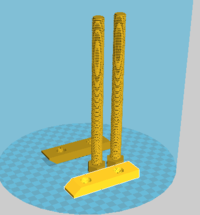No edit summary |
No edit summary |
||
| Line 12: | Line 12: | ||
== Bill of Materials== | == Bill of Materials== | ||
# | ## Food-Safe 3D printer filament. | ||
## 5 (size) nuts and bolts ($0.00) | |||
## | |||
== Tools needed for fabrication of the OSAT== | == Tools needed for fabrication of the OSAT== | ||
# [[AthenaII| MOST Delta RepRap]] or similar RepRap 3-D printer | # [[AthenaII| MOST Delta RepRap]] or similar RepRap 3-D printer | ||
== Technical Specifications and Assembly Instructions== | == Technical Specifications and Assembly Instructions== | ||
# | # To assemble the printed parts, the nuts and bolts are used to: 1) attach the ricer plate to the ricer body 2) attach the ricer arm to the ricer press and the ricer handle 3) attach the ricer handle to the ricer body. | ||
# | # Printing Time requirement: *** minutes | ||
# | # Assembly Time requirement: 5 minutes | ||
# Including drawings or pictures of the device at stage of assembly at minimum. | # Including drawings or pictures of the device at stage of assembly at minimum. | ||
== Cost savings== | == Cost savings== | ||
Revision as of 03:37, 6 December 2019
Potato Ricer
Project developed by User:Matthew K. Makarewicz
Template:Statusboxtop Template:Status-design Template:Status-prototype You can help Appropedia by contributing to the next step in this OSAT's status. Template:Boxbottom
Abstract
- A potato ricer is used as a way to mash potatoes. It is a preferred methods of mashing potatoes. This tool can allow people to improve their quality of cooking without the need to buy specialized tools. All that is needed is a 3D printer and filament. This ricer also have the option of changing out the mesh to produce varying sizes of riced potatoes. It can also be used to rice other foods as well.
- Picture of completed print using your printer

Bill of Materials
- Food-Safe 3D printer filament.
- 5 (size) nuts and bolts ($0.00)
Tools needed for fabrication of the OSAT
- MOST Delta RepRap or similar RepRap 3-D printer
Technical Specifications and Assembly Instructions
- To assemble the printed parts, the nuts and bolts are used to: 1) attach the ricer plate to the ricer body 2) attach the ricer arm to the ricer press and the ricer handle 3) attach the ricer handle to the ricer body.
- Printing Time requirement: *** minutes
- Assembly Time requirement: 5 minutes
- Including drawings or pictures of the device at stage of assembly at minimum.
Cost savings
- If your solution is not a low cost one then it is not really appropriate.
- Estimate your costs
- Find a commercial equivalent, cite it and put the [url in square brackets]
- Calculate $ savings and % savings
Benefited Internet Communities
- Name and add links to at least 5 using single brackets around [url name]
References
- The sources of information (e.g. engineering handbooks, journal articles, government documents, webpages, books, magazine articles etc.). References should use the <ref> </ref> and <references/> tags and can be in any format but should include all the information necessary for someone else to find the same information you did. For example: [1]
- ↑ web page: Department of Energy (DOE) Landscaping and Energy Efficiency, DOE/GO-10095 (1995) Available: http://www.eren.doe.gov/erec/factsheets/landscape.html
Based on the developmental needs addressed (e.g. food, heat, electricity, clean water, health care, etc.) be sure to label your device in the proper categories e.g. use [[Category:Water]]. Be sure to categorize your device so that it will be easy to find – for example “Low voltage connection basics” is categorized in [[Category:How tos]] [[Category:Electricity]] [[Category:Electric lighting]].